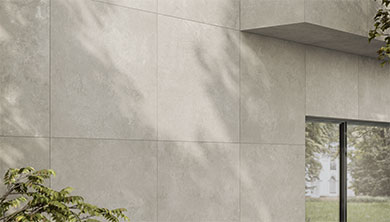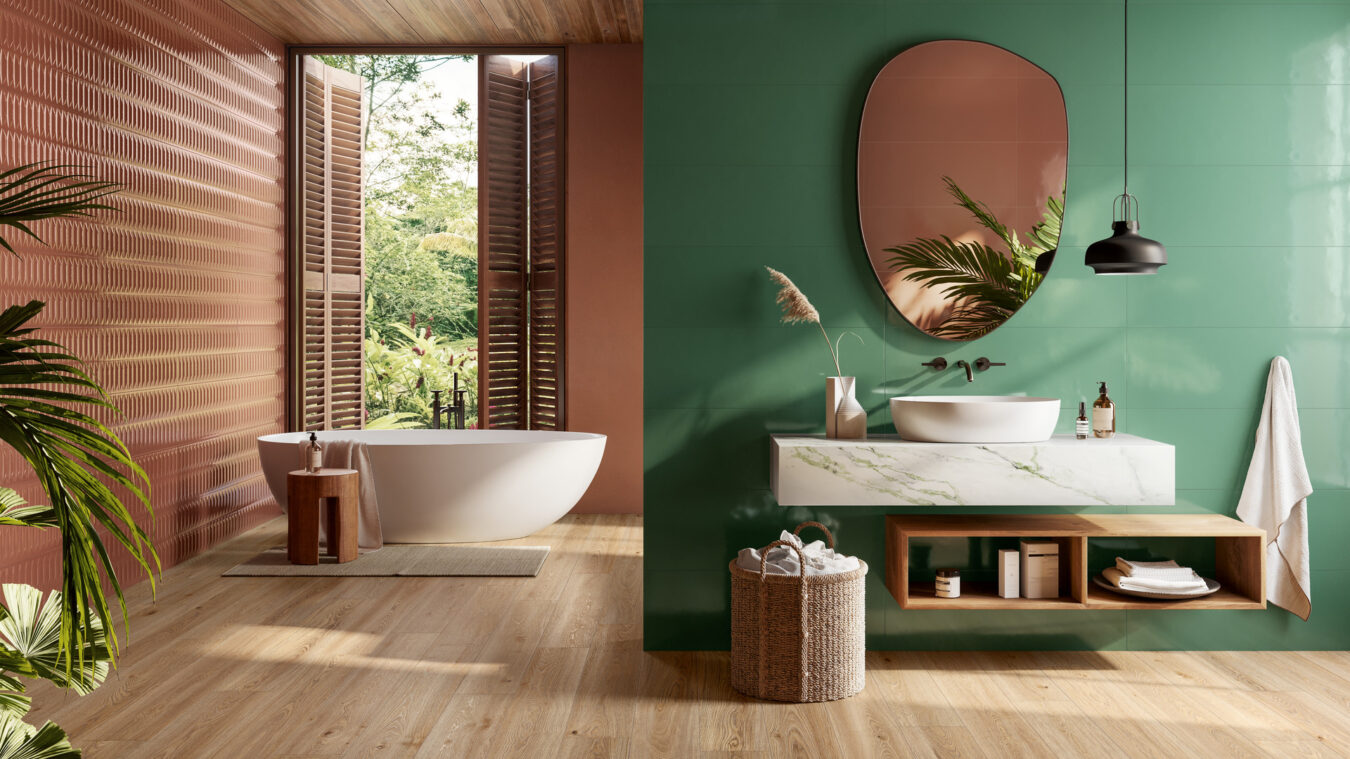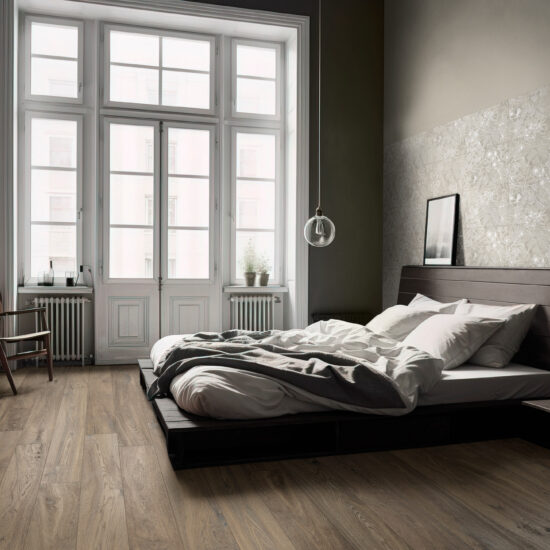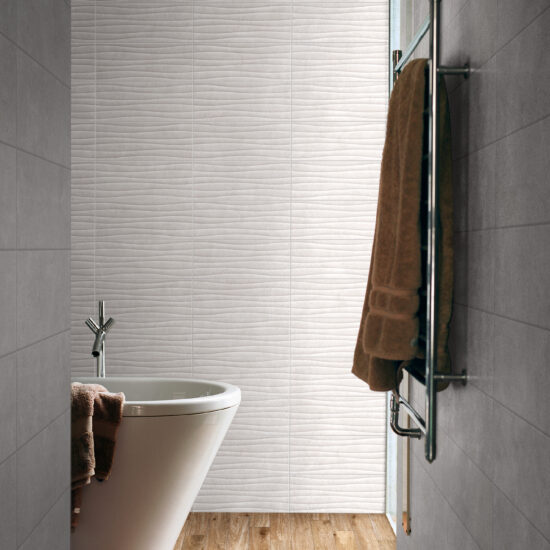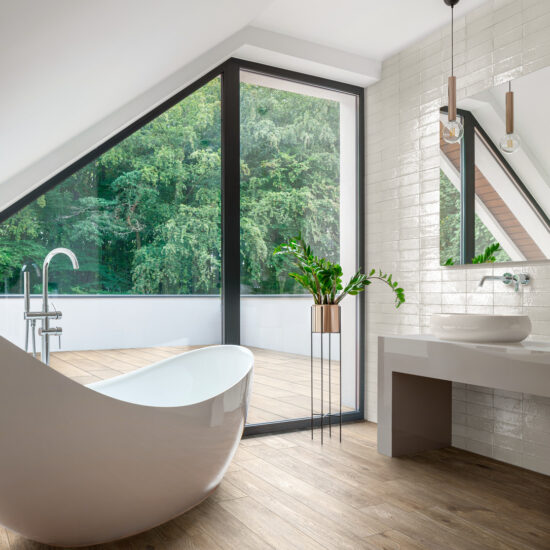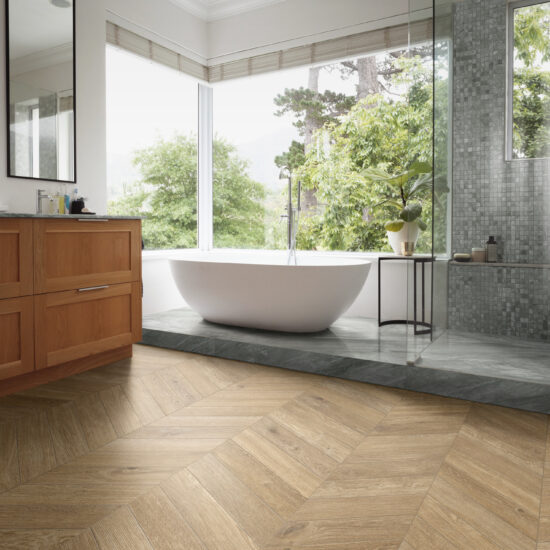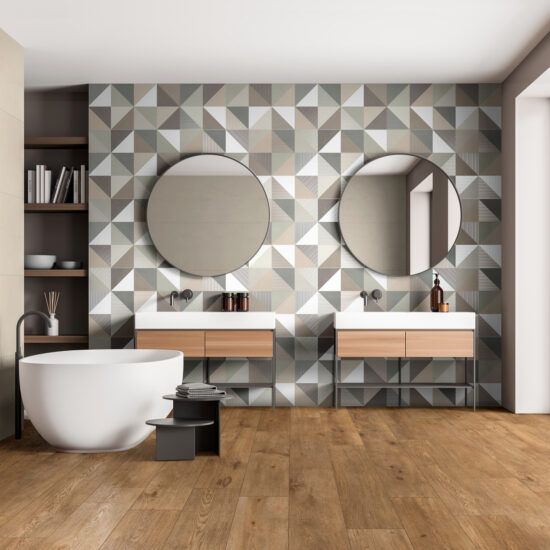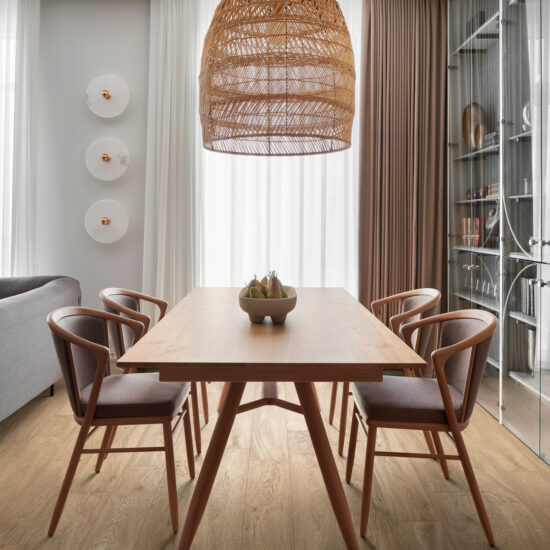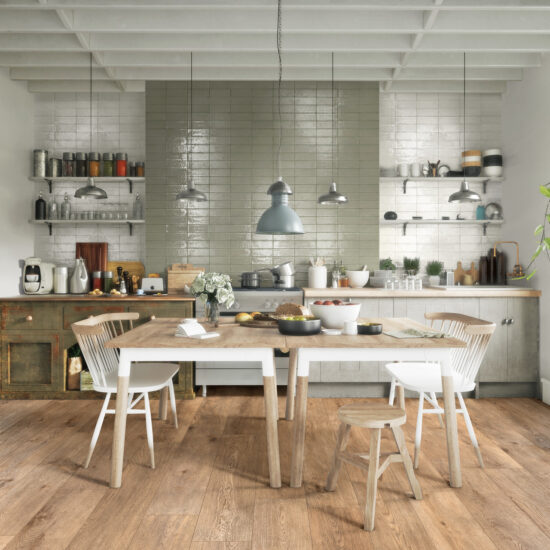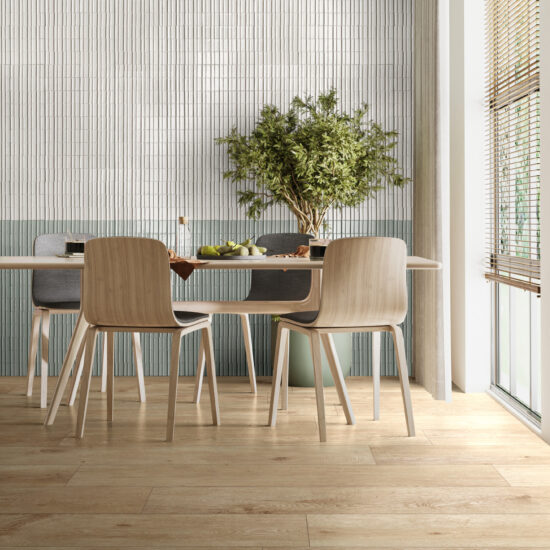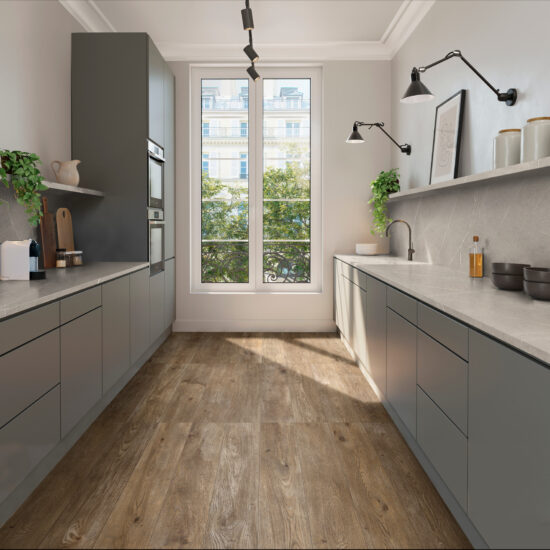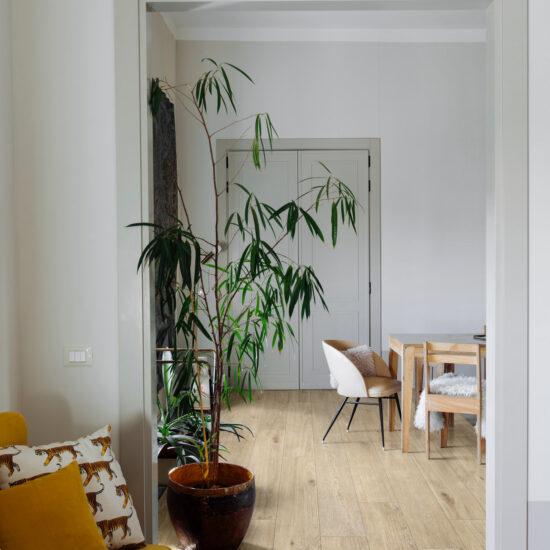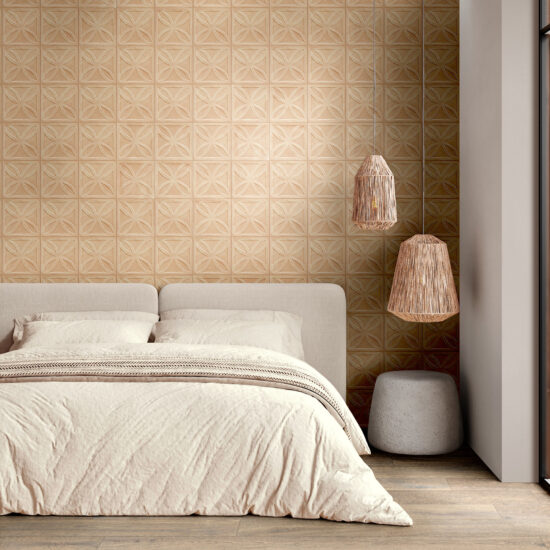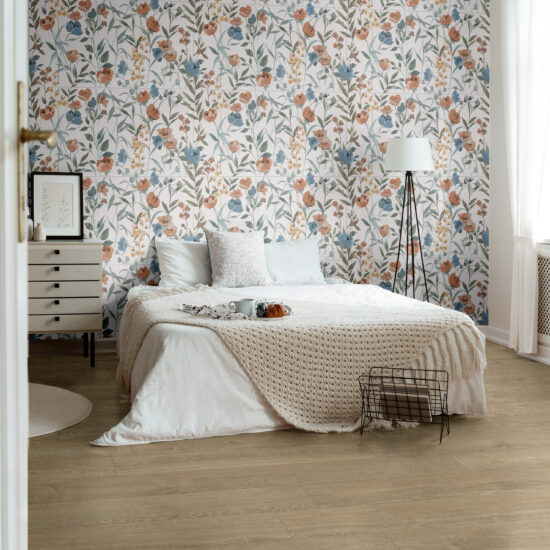Furnishing with wood-effect porcelain stoneware represents one of the most versatile and high-performing solutions for those seeking a warm and natural look, but without the fragility of traditional parquet. While the natural material requires constant maintenance, porcelain stoneware faithfully reproduces the grain and tones of wood with superior resistance to impact, stains, moisture, and temperature changes. Ideal even with underfloor heating, it ensures comfort and design freedom in every space, including the bathroom and kitchen, where natural materials often cannot be used.
In spaces like the bathroom, Ragno’s wood-effect porcelain stoneware collections offer a concrete answer to those wondering which wall coverings are easy to clean, durable, and capable of conveying visual warmth. The result is a surface that combines aesthetics and functionality, able to meet even the most demanding style requirements.
In fact, porcelain stoneware is perfect for creating continuity or for coexisting with other materials, and can even harmoniously match existing parquet, solving the increasingly frequent question: how can I combine parquet and porcelain stoneware?
Material harmonies, colors, and styles for decorating with wood-effect porcelain stoneware
Available in a wide range of finishes and colors, wood-effect porcelain stoneware lends itself to numerous style combinations. Below are the main guidelines for defining the most effective combinations in every type of space, with particular attention to color contrasts, complementary materials, and consistency between rooms.
Color contrasts or continuity? How to choose based on the desired effect
The choice of color plays a crucial role in furnishing with wood-effect porcelain stoneware flooring. Those who want uniform, relaxing spaces can opt for a tone-on-tone approach between floors, walls, and furnishings, choosing light wood types for minimalist spaces or darker ones for a classic and enveloping style. Conversely, those who prefer to highlight the floor can choose strong contrasts: for example, a dark oak floor stands out against white or pearl gray walls, creating depth and character.
The emotions conveyed by each tone are different: light woods visually enlarge spaces and make the room brighter, medium woods evoke balance and naturalness, while dark finishes enhance elegance and intimacy. Each palette should also be evaluated according to the style: an industrial space favors strong contrasts, while a Scandinavian one seeks tonal consistency and lightness.
Matching materials and finishes: a balanced mix of modernity and warmth
In decorating with wood-effect porcelain stoneware, combinations with other materials are fundamental in defining the character of the space. Porcelain stoneware finds a perfect counterpoint in cool surfaces such as metal, glass, or concrete, creating interesting material effects. In a modern or industrial style, these pairings enhance contemporary aesthetics, while in rustic or classic spaces, pairings with natural fabrics, stones, and woods may be preferred.
The finishes of furniture also affect the overall effect. Lacquered finishes, with their shine, visually lighten spaces and pair well with porcelain stoneware in neutral shades, while wood reinforces the sense of material continuity and warmth. When choosing surfaces, you can also play with textures: smooth and matte for a soft effect, or knotty and structured to recall the physicality of real wood.
Designing coherent spaces: how to handle transitions between rooms
Visual uniformity between spaces is one of the main objectives in modern interior design projects. Wood-effect porcelain stoneware, used throughout the kitchen, living room, bedroom, and bathroom, allows you to create a material fil rouge that ties the home together harmoniously. But even if you opt for different flooring from one room to another, you can maintain stylistic consistency by using similar color ranges or connector elements such as matching skirting boards and color-coordinated thresholds.
Managing transitions—especially between indoor and outdoor spaces such as open-plan areas or hallways—deserves attention: wood-effect porcelain stoneware can be combined with decorative tiles or stone-effect surfaces, avoiding harsh color breaks. Here is where small details come into play, such as tone-on-tone grout or skirting finishes, which help reinforce the aesthetic identity of the whole home.
Functionality and style: practical solutions that do not compromise on elegance
In interior design, functionality and style must go hand in hand.
Wood-effect porcelain stoneware in bathrooms demonstrates how a technical material can also offer visual warmth, comfort, and a welcoming feel. For those wondering what to pair with wood-effect porcelain stoneware in the bathroom, there are many answers: white sanitary ware for a classic style, neutral walls for a Nordic style, or concrete inserts and metal accessories for an industrial chic look.
Thanks to its excellent thermal conductivity, wood-effect porcelain stoneware is perfectly suited to underfloor heating systems, allowing for the elimination of radiators and thus freeing up wall space. This translates into greater freedom in furniture arrangement and a more functional use of space, particularly advantageous in smaller bathrooms. At the same time, porcelain stoneware also proves ideal in open-plan spaces, where it helps maintain smooth visual continuity, while still ensuring a clear distinction between different functional areas.
Style inspirations: from Nordic to contemporary rustic
Wood-effect porcelain stoneware plays a leading role in a wide variety of furnishing styles: in the Nordic style, bleached oak prevails, combined with clean lines and light colors such as white and beige for a bright and airy space. In the industrial style, dark woods and tactile textures dominate, with metallic details and minimalist furnishings. Contemporary rustic, on the other hand, prefers warm woods such as walnut, paired with soft lighting and natural materials to create a refined and welcoming atmosphere.
In any case, the success of decorating with wood-effect porcelain stoneware flooring lies in the ability to modulate the material’s aesthetic language to suit the character of the space, enhancing its technical and expressive qualities.
Matching doors to wood-effect porcelain stoneware flooring
One of the most frequently asked questions is: which doors can be paired with wood-effect porcelain stoneware?
The answer depends on the desired aesthetic result. For contemporary and bright spaces, white doors are always a winning choice, as they amplify the light and lighten the visual impact. For those wishing to reinforce continuity, tone-on-tone doors can be chosen, perhaps in the same wood species or shade as the porcelain stoneware, for an elegant and consistent result.
Where space allows, you can also be bold with colored or strongly contrasting doors, as long as the combination follows a stylistic logic: the important thing is that the choice of doors is not disconnected from the rest of the decor and is considered as an integral part of the project. For those seeking ideas on how to pair doors with wood-effect porcelain stoneware flooring, the advice is to observe the existing palettes and decide whether to highlight the contrast or emphasize continuity.
Harmonizing different spaces with wood-effect porcelain stoneware
When different furnishings are chosen from room to room, maintaining visual consistency can seem difficult. In reality, thanks to the flexibility of porcelain stoneware, it is possible to create harmonious solutions even in complex contexts. The floor becomes the connecting element: laid continuously or with slight tone variations, it leads the eye from one space to another, facilitating dialogue between different styles and proving ideal for a modern solution in spaces such as the bedroom.
In transitional areas such as hallways and entrances, it is important not to create excessive breaks, but rather to accompany the change in style with visual tricks: the same porcelain stoneware can be laid in different ways, or combined with complementary surfaces to suggest a fluid evolution of the space.
Final tips for a furnishing project with wood-effect porcelain stoneware
During the design phase, functionality should not be overlooked, as it should always take precedence over the aesthetic component.
Every choice should stem from real needs: comfort, durability, and ease of maintenance. Only in this way can furnishing with wood-effect porcelain stoneware fully express its potential, transforming every space into a perfect balance between technique and beauty.
Discover Ragno collections and be inspired by wood-effect combinations designed to give new shape to your spaces: harmonious, welcoming, and with unmistakable design.






